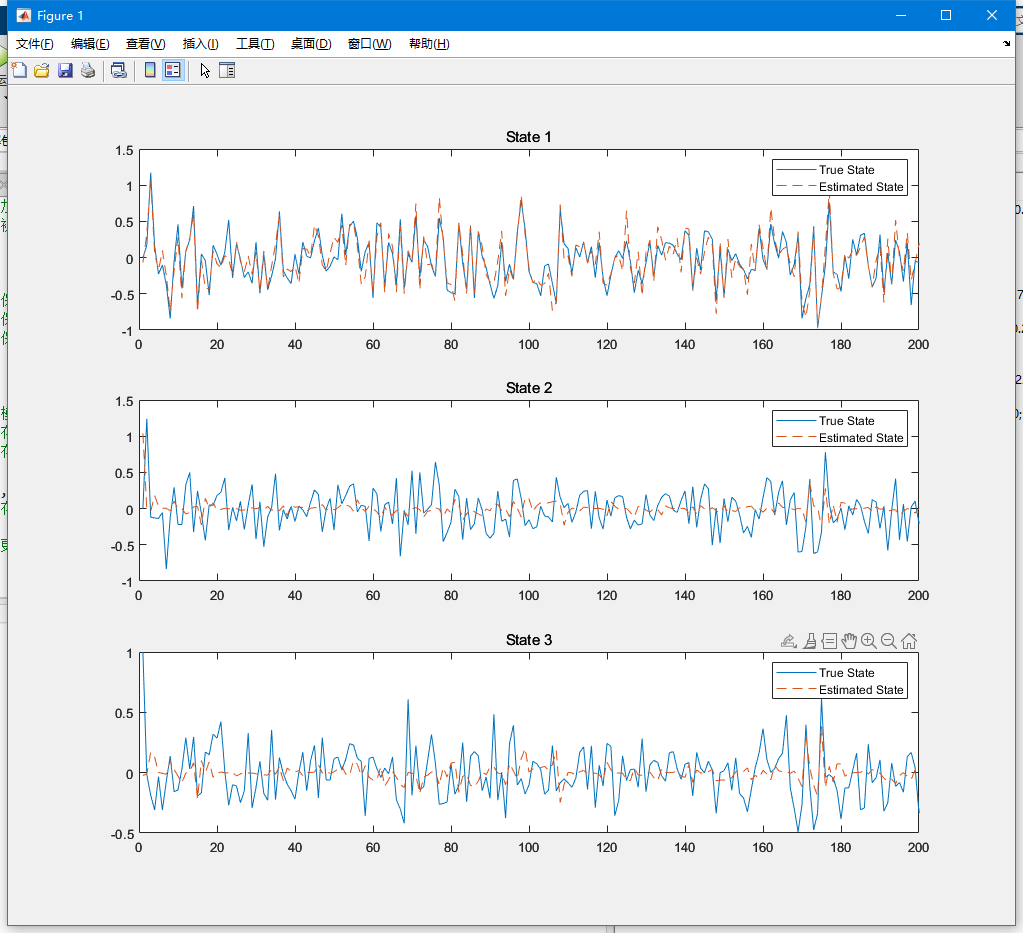
clear all;
close all;
clc;
%% 上面是调用卡尔曼滤波
% 定义状态维数和初始条件
n = 3; % 状态维数
q = 0.2; % 过程噪声标准差
r = 0.15; % 测量噪声标准差
Q = q * eye(n); % 过程噪声协方差矩阵
R = r^2; % 测量噪声协方差矩阵
fstate = @(x)[x(2); x(3); 0.5*x(1)*(x(2) + x(3))]; % 状态转移方程
hmeas = @(x)x(1); % 测量方程% 初始化状态和协方差矩阵
s = [0; 0; 1]; % 真实初始状态
x = s + q * randn(3,1); % 加入噪声的初始状态估计
P = eye(n); % 初始状态协方差矩阵% 模拟参数
N = 200; % 动态步数
xV = zeros(n, N); % 保存状态估计值
sV = zeros(n, N); % 保存真实状态值
zV = zeros(1, N); % 保存测量值% 开始模拟
for k = 1:Nz = hmeas(s) + r * randn; % 模拟测量值sV(:, k) = s; % 存储真实状态值zV(k) = z; % 存储测量值[x, P] = ukf(fstate, x, P, hmeas, z, Q, R); % 调用UKFxV(:, k) = x; % 存储状态估计值s = fstate(s) + q * randn(3, 1); % 更新真实状态
end% 绘制结果
for k = 1:3subplot(3, 1, k)plot(1:N, sV(k, :), '-', 1:N, xV(k, :), '--')title(['State ', num2str(k)])legend('True State', 'Estimated State')
endfunction X=sigmas(x,P,c)%Sigma points around reference point%Inputs:% x: reference point% P: covariance% c: coefficient%Output:% X: Sigma pointsA = c*chol(P)';Y = x(:,ones(1,numel(x)));X = [x Y+A Y-A]; endfunction [y,Y,P,Y1]=ut(f,X,Wm,Wc,n,R)%Unscented Transformation%Input:% f: nonlinear map% X: sigma points% Wm: weights for mean% Wc: weights for covraiance% n: numer of outputs of f% R: additive covariance%Output:% y: transformed mean% Y: transformed smapling points% P: transformed covariance% Y1: transformed deviationsL=size(X,2);y=zeros(n,1);Y=zeros(n,L);for k=1:L Y(:,k)=f(X(:,k)); y=y+Wm(k)*Y(:,k); endY1=Y-y(:,ones(1,L));P=Y1*diag(Wc)*Y1'+R; endfunction [x,P]=ukf(fstate,x,P,hmeas,z,Q,R)
% UKF Unscented Kalman Filter for nonlinear dynamic systems
% [x, P] = ukf(f,x,P,h,z,Q,R) returns state estimate, x and state covariance, P
% for nonlinear dynamic system (for simplicity, noises are assumed as additive):
% x_k+1 = f(x_k) + w_k
% z_k = h(x_k) + v_k
% where w ~ N(0,Q) meaning w is gaussian noise with covariance Q
% v ~ N(0,R) meaning v is gaussian noise with covariance R
% Inputs: f: function handle for f(x)
% x: "a priori" state estimate
% P: "a priori" estimated state covariance
% h: fanction handle for h(x)
% z: current measurement
% Q: process noise covariance
% R: measurement noise covariance
% Output: x: "a posteriori" state estimate
% P: "a posteriori" state covariance
%
% Example:
%{
n=3; %number of state
q=0.1; %std of process
r=0.1; %std of measurement
Q=q^2*eye(n); % covariance of process
R=r^2; % covariance of measurement
f=@(x)[x(2);x(3);0.05*x(1)*(x(2)+x(3))]; % nonlinear state equations
h=@(x)x(1); % measurement equation
s=[0;0;1]; % initial state
x=s+q*randn(3,1); %initial state % initial state with noise
P = eye(n); % initial state covraiance
N=20; % total dynamic steps
xV = zeros(n,N); %estmate % allocate memory
sV = zeros(n,N); %actual
zV = zeros(1,N);
for k=1:Nz = h(s) + r*randn; % measurmentssV(:,k)= s; % save actual statezV(k) = z; % save measurment[x, P] = ukf(f,x,P,h,z,Q,R); % ekf xV(:,k) = x; % save estimates = f(s) + q*randn(3,1); % update process
end
for k=1:3 % plot resultssubplot(3,1,k)plot(1:N, sV(k,:), '-', 1:N, xV(k,:), '--')
end
%}
% Reference: Julier, SJ. and Uhlmann, J.K., Unscented Filtering and
% Nonlinear Estimation, Proceedings of the IEEE, Vol. 92, No. 3,
% pp.401-422, 2004.
%
% By Yi Cao at Cranfield University, 04/01/2008
%L=numel(x); %numer of statesm=numel(z); %numer of measurementsalpha=1e-3; %default, tunableki=0; %default, tunablebeta=2; %default, tunablelambda=alpha^2*(L+ki)-L; %scaling factorc=L+lambda; %scaling factorWm=[lambda/c 0.5/c+zeros(1,2*L)]; %weights for meansWc=Wm;Wc(1)=Wc(1)+(1-alpha^2+beta); %weights for covariancec=sqrt(c);X=sigmas(x,P,c); %sigma points around x[x1,X1,P1,X2]=ut(fstate,X,Wm,Wc,L,Q); %unscented transformation of process% X1=sigmas(x1,P1,c); %sigma points around x1% X2=X1-x1(:,ones(1,size(X1,2))); %deviation of X1[z1,Z1,P2,Z2]=ut(hmeas,X1,Wm,Wc,m,R); %unscented transformation of measurmentsP12=X2*diag(Wc)*Z2'; %transformed cross-covarianceK=P12*inv(P2);x=x1+K*(z-z1); %state updateP=P1-K*P12'; %covariance update
end



-业务分析模型)

)




![[每周一更]-(第96期):Rsync 用法教程:高效同步文件与目录](http://pic.xiahunao.cn/[每周一更]-(第96期):Rsync 用法教程:高效同步文件与目录)







